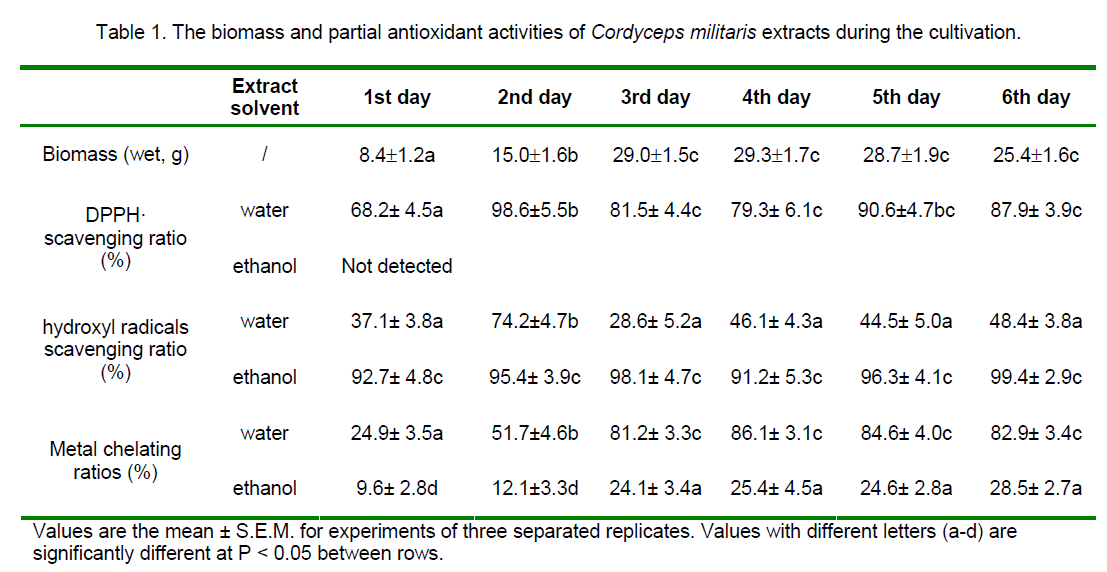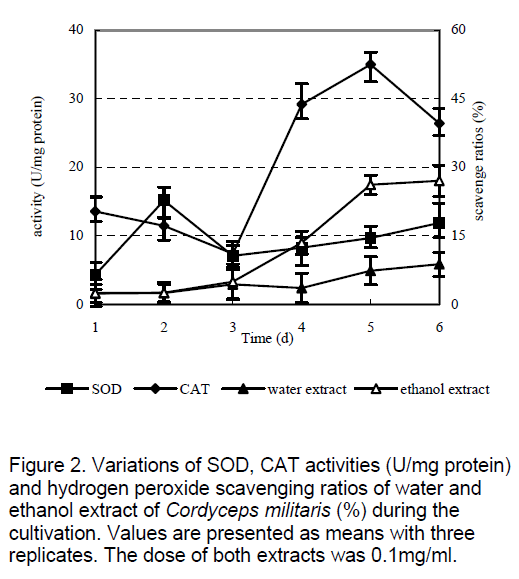The Varieties of Antioxidant Activity of Cordyceps Militaris During the Submerged Fermentation
Yuxiang Gu, Zunsheng Wang, Qinsheng Yuan
Yuxiang Gu1,Zunsheng Wang1,2,Qinsheng Yuan1,*
The State Key Laboratory of Bioreactor Engineering,East China University of Science and Technology,Shanghai 200237,P.R.China
Institute of Chemistry and Life Science,Shenyang Normal University,Shenyang 110034,P.R.China
Abstract
The present work is to investigate the variations in antioxidant activity of Cordyceps militaris grown using the submerged cultivation. The activities of intracellular antioxidant enzymes, superoxide dismutase (SOD) and catalase (CAT), and the antioxidant abilities of water and ethanol extracts of cultured C. militaris were tested. The intracellular oxidative stress in C. militaris was significantly increased after 3 days’ cultivation. However, for most of the enzymes and extracts, the antioxidant activity time profiles did not follow the trend of oxidative stress. There were great variations in the antioxidant activities, possibly due to the different requirements of the cells during cultivation. The results also suggest that C. militaris resisted the damage from superoxide anion mainly with SOD, and resisted the damage from hydrogen peroxide with both CAT and antioxidant compounds.
Keywords
Antioxidant; variety; Cordyceps militaris; fermentation.
1. Introduction
As a famous traditional Chinese medicine,Cordyceps militaris is one of the critical ingredients in many Chinese traditional prescriptions and has broad pharmacological effects and properties. Since it is very scarce in nature,fermentation preparations of the species have been accepted as medicines or supplements in eastern countries.
Since antioxidant activity is among the first links between chemical and biological activities,the evaluation of the antioxidant ability of Cordyceps militaris is crucial. However,little work has been done in this aspect [1]. Moreover,no previous work has reported the changes in antioxidant activity of cultured C. militaris during fermentation. The aim of the study is to investigate the varieties in antioxidant activity of intracellular antioxidant enzymes and water and ethanol extracts of C. militaris throughout the cultivation period. The antioxidative enzymes include superoxide dismutase (SOD) and catalase (CAT),which scavenge superoxide anion and hydrogen peroxide,respectively. The extracts of C. militaris contain compounds such as polyphenols,mannitol and polysaccharide that have potential antioxidant activities.
2. Materials and methods
2.1 Samples
Natural Cordyceps militaris was collected from Liaoning,China. The fermentation process of C. militaris was carried out according to the Wang protocol [2],and the duration of cultivation ranged from 1 to 6 days.
2.2 Antioxidant activity of enzymes
The fermentation productions were prepared according to the Wang protocol [2]. Intracellular assays included determination of lipid peroxidation (LPO) values [3],SOD activity [4] and CAT activity [5]. Protein was measured according to the Bradford method [6].
2.3 Antioxidant activity of water and ethanol extracts
The fermentation productions were first centrifuged at 4000 g for 20 min. The mycelium was dried to constant weight and homogenized to powder. About 5 g of sample in 100 ml ethanol or water was extracted by ultrasonic cell crushing,and then centrifuged at 10000 g for 15 min. The residue was re-extracted until the extraction solvents became colourless. The supernatant was combined and vacuum-evaporated on a water bath at 50 until ÃÆâÃâââ¬Å¾ÃâÃâdry.
The inhibition of linoleic acid oxidation was estimated based on thiobarbituric acid (TBA) reactivity. Samples were evaluated for malondialdehyde (MDA) production using a spectrophotometric assay for TBA [7]. The lower the absorbance at 500 nm,the more powerful the antioxidants were. The scavenging activity of 1,1-diphenyl-2-picryl-hydrazil (DPPH•) was measured by classical method [8]. The ability of eliminating hydrogen peroxide was determined according to Beers [9]. The activity of scavenging hydroxyl radicals was tested spectrophotometrically [10]. Superoxide anion scavenging assay was based on the inhibitory effect on the spontaneous autoxidation of pyrogallol [4]. Metal reducing power was assayed according to Oyaizu’s method [11]. Increased absorbance of the reaction mixture at 700 nm indicated increased reducing power. The chelation of ferrous ions was estimated by the method of Dinis [12]. The concentration of all extracts was 0.1 mg/ml.
3. Results and discussion
3.1 Lipid perioxidation level
A sharp increase in lipid perioxide level was observed in Figure 1 between the 3rd and 4th day (from 1.45 to 2.52 nmol/g). However,when cells entered the stationary growth phase,the lipid perioxidation level increased slowly. Thus,the intracellular oxidative stress was not high until the late exponential phase. The time profiles of inhibitory effects on linoleic acid oxidation exhibited the opposite trend for both extracts. Before the 3rd day,the antioxidant activity increased slowly; from the 3rd to 4th day,it suddenly increased (the absorbance at 500 nm decreased from 0.512 to 0.279 of water extract,and from 0.581 to 0.285 of ethanol extract,respectively). After the 5th day,the increase became slow again. The above results indicate that serious intracellular oxidative stress from the 3rd day induced the production of antioxidant compounds with lipid perioxidation inhibitory activity. Thus,the antioxidant activities of C. militaris extracts in linoleic acid oxidation mainly reflect the intracellular oxidative status of C. militaris.
Figure 1. Variations of MDA (nmol/g) and inhibitory effects of water and ethanol extract of Cordyceps militaris on linoleic acid oxidation (absorbance at 500 nm) during the cultivation. For inhibition of linoleic acid oxidation assay, the lower the absorbance at 500 nm, the more powerful the antioxidants are. Values are presented as means with three replicates.
3.2 Superoxide anion and hydroxyl radicals scavenging activity of enzymes and extracts
The time profiles of SOD activities showed two maxima (Figure 2 ),at the early exponential phase (at the 2nd day,15.2 U/mg protein) and the late stationary phase (at the 6th day,11.9 U/mg protein),respectively. However,both extracts of C. militaris showed poor ability in scavenging superoxide anion throughout fermentation (data not shown). Thus,C. militaris resisted the damage from superoxide anion mainly with SOD.
The intracellular CAT activities also showed two maxima at the 1st day (13.6 U/mg protein) and the 5th day (35.0 U/mg protein),respectively (shown in Figure 2 ). The hydrogen peroxide scavenging activity of water extract was low,but the corresponding ethanol extract exhibited considerable activity compared with CAT,especially after 4 days’ cultivation (the scavenge ratios were higher than 13.5 % after that). Moreover,since the H2O2-scavenging activities of both CAT and antioxidant compounds in extracts began to raise sharply almost in same trend after the first maxima of SOD activity,it was presumed that the hydrogen peroxide reduced by SOD could induce the productions of CAT and non-enzyme antioxidant compounds. Although we could not simply assume that all these H2O2-eliminating compounds in extracts were synthesized directly as the scavengers of hydrogen peroxide,both CAT and these antioxidants should participate in scavenging hydrogen peroxide during the fermentation.
3.1 Other antioxidant activity
The variations of other antioxidant activities of both extracts were summarized in Table 1. Results showed that the DPPH• scavenging ratios of water extract showed two maxima,however,the corresponding ethanol extract showed no significant activity.

A significant increase in the scavenging ratios of hydroxyl radicals for the water extract occurred after only one day’s fermentation,then suddenly declined on the 3rd day and increased steadily until the fermentation was completed. On the contrary,the scavenging ratios of its corresponding ethanol portion remained at nearly 100 % throughout the whole culture.
The ability of chelating metal ions of both extracts showed an almost linear increase within the first 3 days,then it maintained reposefully. The water extract showed much higher activity and increasing speed than the ethanol extract
No significant changes of C. militaris extracts were observed by evaluation with metal reducing power; the absorbance at 700 nm of both extracts was around 0.07 all through (data not shown).
The varieties in different antioxidant activities of C. militaris were complicated,indicating that the antioxidant enzymes and compounds accumulated in different quantities according to the requirements of the cells under the oxidative stress. If the components with certain antioxidant ability are most needed under oxidative stress,are produced in large amount by C. militaris immediately (such as the antioxidants with metal chelating activity). On the contrary,the quantities of some antioxidants with certain activity did not significantly change because they were not highly needed in this situation (such as antioxidants with metal reducing power).
References
- Alipio BC,David FC,Isabel RS,Juan CNM. Manuel AE. Comparison of batch,stirred flow chamber,and column experiments to study adsorption,Desorption and transport of carbofuran within two acidic soils. Chemosphere. 2012; 88(1): 106-120.
- Arnaud B,Richard C,Michel S. A comparison of five pesticides adsorption and Desorption processes in thirteen contrasting field soils. Chemosphere. 2005; 61(5): 668-676.
- Chunxian W,Jin-Jun W,Su-Zhi Z,Zhong-Ming Z. Adsorption and Desorption of Methiopyrsulfuron in Soils. Pedosphere. 2011; 21(3): 380-388.
- Chunxian W,Suzhi Z,Guo N,Zhongming Z,Jinjun W. Adsorption and Desorption of herbicide monosulfuron-ester in Chinese soils. J Environ Sci. 2011; 23(9): 1524-1532.
- Christine MFB,Josette MF. Adsorption-desorption and leaching of phenylurea herbicides on soils. Talanta. 1996; 43(10): 1793-1802.

Open Access Journals
- Aquaculture & Veterinary Science
- Chemistry & Chemical Sciences
- Clinical Sciences
- Engineering
- General Science
- Genetics & Molecular Biology
- Health Care & Nursing
- Immunology & Microbiology
- Materials Science
- Mathematics & Physics
- Medical Sciences
- Neurology & Psychiatry
- Oncology & Cancer Science
- Pharmaceutical Sciences


